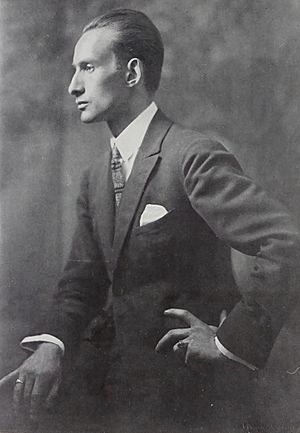Christian Schad facts for kids
Quick facts for kids
Christian Schad
|
|
|---|---|

Christian Schad in a photograph by Franz Grainer (1912)
|
|
| Born | 21 August 1894 Miesbach, Upper Bavaria, German Empire
|
| Died | 25 February 1982 (aged 87) |
| Nationality | German |
| Known for | Painting, photography |
| Movement | Expressionism, New Objectivity, Dada |
Christian Schad (born August 21, 1894 – died February 25, 1982) was a German artist. He was known for his paintings and photographs. Schad was part of two important art movements: Dada and New Objectivity. His portraits show what life was like in cities like Vienna and Berlin after World War I.
Contents
Christian Schad's Life and Art
Early Life and Artistic Beginnings
Christian Schad was born in Miesbach, Germany. His father was a wealthy lawyer who supported him for many years. In 1913, Schad began studying art in Munich.
In 1915, he moved to Switzerland to avoid fighting in World War I. He lived in Zurich and later in Geneva. While in Zurich, he saw the start of the Dada art movement. Dada artists liked to create art that was unusual and challenged traditional ideas.
Creating Schadographs
In 1919, Schad started making unique photographs. He called them Schadographs. These were made by placing flat objects on special paper and exposing them to sunlight. This created interesting shadow images.
His friend, Walter Serner, was very excited about these new works. Another artist, Tristan Tzara, published one of Schad's works in a Dada magazine in 1920. This was before other famous artists made similar types of photos. The name Schadograph was later given to these works by Tzara.
Life in Italy and Vienna
From 1920 to 1925, Schad lived in Naples, Italy. He married Marcella Arcangeli, whose father was a professor. While in Naples, he continued to study painting and drawing.
In 1927, his family moved to Vienna. During this time, his paintings became part of the New Objectivity art movement. This style focused on showing things in a very clear and realistic way. Later, he moved back to Berlin.
Challenges and Later Years
Around 1930, Schad became interested in Eastern philosophy. His art production slowed down. After a big stock market crash in 1929, his father could no longer support him financially. Because of this, Schad mostly stopped painting in the early 1930s.
During the time of the Nazis in Germany, Schad's art was not banned. Unlike many other artists, his work was even shown in a special exhibition called Great German Art in 1937. This was the Nazis' way of showing art they approved of. Recent studies show that Christian Schad joined a political party in 1933.
Schad lived quietly in Germany during and after the war. In 1943, his art studio was destroyed. He then moved to Aschaffenburg. His future wife, Bettina, bravely saved many of his artworks from the destroyed studio. She brought them to him in Aschaffenburg.
Schad continued to paint in a style called Magic Realism in the 1950s. In the 1960s, he went back to experimenting with his photograms. His art became more recognized again in the 1960s.
Christian Schad passed away in Stuttgart on February 25, 1982.
Christian Schad's Artworks
Schad's art includes paintings, photographs, Schadographs, graphic works, drawings, and watercolors.
His Painting Style
In 1915–1916, Schad's paintings showed influences from Cubism and Futurism. These styles used geometric shapes and showed movement.
When he lived in Naples in the 1920s, he developed a smooth, realistic painting style. He admired the clear style of Raphael's paintings. When he returned to Berlin in 1927, he created some of his most famous works in the New Objectivity style. These paintings are known for their very sharp and detailed look.
The Story of Schadographs
Christian Schad made his first Schadographs in 1919 in Geneva. He used a special kind of paper that reacted to light. He would place everyday objects on the paper and expose it to the sun. This created unique shadow pictures.
His friend Tristan Tzara was very impressed. He published one of Schad's "photographic compositions" in his Dada magazine. This was years before other artists like Man Ray made similar works. The name Schadograph was given to these works by Tzara in 1937.
Interestingly, Christian Schad forgot about these early photographic works for a while. He had sent all 28 original Schadographs to Tristan Tzara, who never returned them. In the 1950s, an art critic reminded Schad about them. In the 1960s, Schad made new versions of his Schadographs. He used different paper and worked in a darkroom instead of using the sun.
Recognition and Legacy
Today, Christian Schad's artworks are in major art collections. These include the Museum of Modern Art in New York, the Tate in London, and the Neue Nationalgalerie in Berlin.
The first big exhibition of his work in the United States was held in New York in 2003. In 2002, Schad's second wife, Bettina, started the Christian Schad Foundation in Aschaffenburg. This foundation has over 3,200 of his artworks. The Christian Schad Museum in Aschaffenburg opened in June 2022. It shows a changing selection of his unique works.
See also
 In Spanish: Christian Schad para niños
In Spanish: Christian Schad para niños
- Otto Dix
- George Grosz
- Rudolf Schlichter
- Karl Hubbuch

